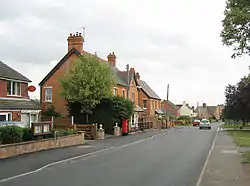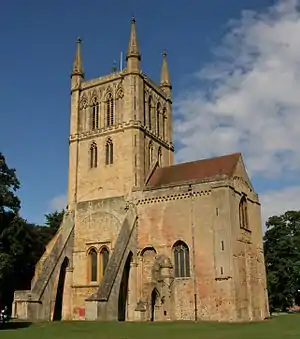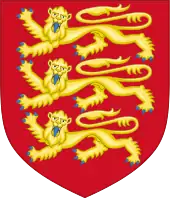Adam de Harvington
Adam de Harvington or de Herwynton (c.1270-c.1345) was a fourteenth-century Crown official and judge who had a successful career in both England and Ireland. He held office as Chief Baron of the Irish Exchequer and as English Chancellor of the Exchequer, and acquired considerable wealth as a result.[1]

Family
He derived his name from his birthplace, Harvington, Worcestershire; he was the son of William de Harvington or de Herwynton.[2] His close association with Pershore Abbey suggests that William de Harvington, Abbot of Pershore 1307-40, was his relative.

Career
His path to high office lay through the patronage of Guy de Beauchamp, 10th Earl of Warwick (died 1315). It was probably Warwick who obtained for him the position of Deputy Chamberlain of the Exchequer in 1298 and persuaded Edward I to grant him the manor of Talton, Worcestershire, in 1303.[3] He was given the living of Awre, Gloucestershire in 1305 and of Hanslope in 1316. He was an executor of Warwick's will in 1315 and was given a lease of certain of his lands for fifteen years. In his own will he made clear his great sense of obligation to the Earl.[4]
His association with the Diocese of Worcester had begun by 1305 when he accompanied the Bishop of Worcester, William Gainsborough, on a journey overseas;[5] in the 1320s he is found regularly acting as Vicar-general of the Diocese.[6]
After Warwick's death Adam acquired a new patron: this was Edward I's nephew, Thomas, 2nd Earl of Lancaster. Adam became Keeper of the Rolls of the Bench at Westminster in 1314 and was a Commissioner of oyer and terminer 1314-1322.[7] Any setback he may have suffered in his career after Lancaster's downfall and execution for treason in 1322 was temporary: he seems to have been regarded as a valued and hard working Crown official.[8] He was sent to Ireland as Chief Baron in 1324,[9] and was briefly Chancellor of the Exchequer of Ireland; he returned to England as Chancellor of the Exchequer in 1327.
Last years
He retired to his native Worcestershire in 1330. In his last years he was a noted benefactor of Pershore Abbey. Ball gives his date of death as 1337,[10] but this is probably a mistake, since he made a conveyance of land in 1342; he was certainly dead by 1346. In his will he left money to Pershore Abbey to erect a chantry to pray for his soul and that of his first patron Guy, Earl of Warwick.[11]
References
- Ball, F. Elrington The Judges in Ireland 1221-1921 John Murray London 1926 Vol.i p. 25
- Ball p.66
- Ball p.66
- Willis-Bund, J.W. Page, William editors History of the County of Worcester 1971 Vol.2 pp. 127-136
- Ball p.66
- Haines, Roy Martin Church and Politics in Fourteenth-century England: the career of Adam Orleton Cambridge University Press 2005 p.89
- Ball p.67
- Haines p.89
- Ball p.25
- Ball p.67
- Willis-Bund, Page pp.127-136
